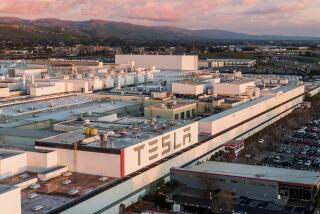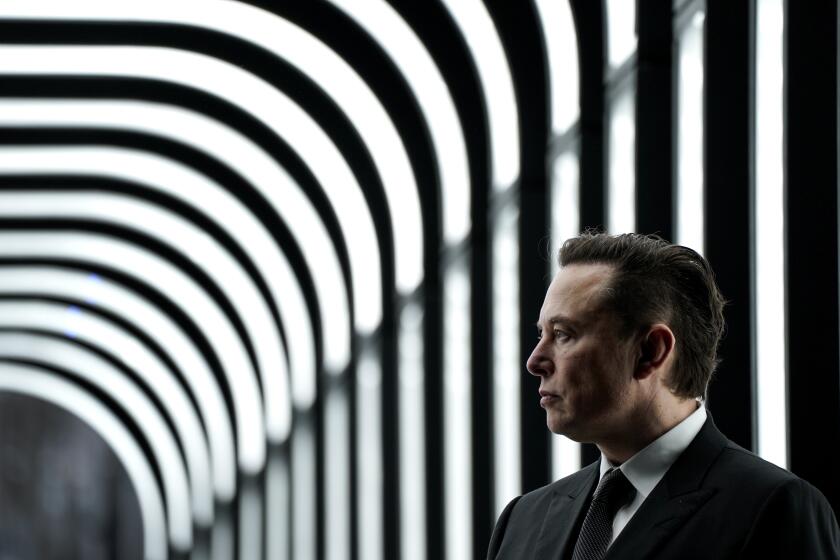The end of an era in California automaking
- Share via
LOS ANGELES AND FREMONT, CALIF. — Toyota Motor Corp.’s decision to abandon its assembly line in Fremont marks the end of large-scale auto manufacturing in California, which over the years boasted a dozen or more plants building vehicles ranging from Studebakers to Camaro muscle cars.
The Japanese automaker said Thursday that it would end production at the plant March 31, throwing 4,700 people out of work, and return some production to Japan.
It’s another hard blow for California, a state already grappling with an 11.9% unemployment rate -- its highest since World War II and the fourth-worst in the nation.
In addition to wiping out the jobs directly tied to the plant, closing the facility will send ripples through the web of suppliers that make components for the factory and through nearby stores, restaurants and bars that depend on its workers for business.
Overall, closing the plant could cost more than 40,000 jobs, according to Sen. Dianne Feinstein (D-Calif.), who has worked with other public officials to try to keep the plant open. But communications with Toyota eventually broke down, she said.
Operated as a joint venture between Toyota and the former General Motors Corp. since 1984, the plant saw its future put in doubt last month when GM pulled out of the arrangement as part of its bankruptcy reorganization.
Executives of the venture, New United Motor Manufacturing Inc., told union members Thursday morning about Toyota’s decision. It is the first time that Toyota has ever closed a major auto assembly plant.
Assembly line worker Jose Hernandez, 40, who commutes 75 miles to the plant from the Central Valley town of Ceres, said the news was a bit surprising because the plant had been busy since the government’s “cash for clunkers” program jump-started auto sales this month.
“What can I do, look for a job, which is going to be very difficult right now?” he asked.
End of an era
Shutting down the plant will be another milepost in the long erosion of California’s once-thriving auto industry -- a decline that is being only partly offset by the rise of a new breed of start-up car companies specializing in such advanced technology as all-electric drivetrains.
The old plants with their union payrolls provided a vital boost into the middle class for many Californians.
“The auto industry was very important in this state,” said Jack Kyser, economist for the Los Angeles County Economic Development Corp. “You could be a less-than-stellar student in high school and go to work on an assembly line, and pretty soon you were making good wages with good benefits.”
Many of the shuttered plants were either bulldozed or converted into shopping malls, where paychecks for retail clerks typically are much skimpier. The old GM plant in Van Nuys is now a shopping center anchored by Home Depot, for instance, and a Samson Tire & Rubber factory in City of Commerce was turned into the Citadel mall.
Analysts say those better-paying union jobs, along with other costs of doing business in California, are big reasons that California’s auto production has fled overseas or to other, lower-cost states.
The Fremont plant, which makes Corolla compact cars and Tacoma pickups for Toyota and, until last week, Pontiac Vibe hatchbacks for GM, was the Japanese company’s only U.S. auto plant with a union workforce. As Japanese and German automakers opened vehicle production to the U.S. beginning in the 1980s, they often have opted for states such as Kentucky, Texas and Alabama, where union shops are more rare.
“It just made sense for Toyota to pull the plug,” said Dennis Virag, president of the Automotive Consulting Group in Ann Arbor, Mich. “When you look at states like Kentucky and Tennessee, California just isn’t competitive in manufacturing with its taxes, regulations and overall cost of doing business.”
The costs apparently outweighed a package of incentives put together by state and local officials in an effort to persuade Toyota to stay in Fremont. The incentives included tax breaks, lower utility rates and publicly funded road and rail improvements around the plant, according to Feinstein.
State Sen. Dave Cox (R-Fair Oaks) said an executive from the Fremont plant had expressed concern to lawmakers about the state’s workers’ compensation system, overtime laws and employee leave requirements.
Cutting production
On Thursday, Toyota blamed the end of the joint venture on GM’s decision to pull out of the arrangement. It also said that producing cars at Fremont wasn’t “economically viable” given the current auto market, the worst in decades. The automaker, which reported its largest-ever annual loss this year, has been cutting production in Japan and elsewhere amid falling sales.
Atsushi Niimi, a Toyota executive vice president, said the union presence didn’t influence the decision to close the plant. But he acknowledged that “California’s cost of living is relatively high, which leads to higher labor costs compared to other regions.”
Public officials who had lobbied Toyota said they were disappointed by the automaker’s decision. Feinstein noted that she had spoken several times to the head of Toyota’s U.S. operations and had written to Chief Executive Akio Toyoda, grandson of the company’s founder, to offer help in keeping the plant open.
“Yet as the days went on, the officials at Toyota grew more remote and less transparent,” Feinstein said. “My calls were not returned, which gave me the distinct idea and view that they were going to withdraw from the venture.”
Public officials groused that the decision came just days after news that Toyota garnered the biggest share of the $3-billion, taxpayer-funded “cash for clunkers” program. The Corolla -- built in Fremont and a plant in Canada -- was the program’s top-selling model.
Assembly line worker Hernandez, who also is a United Auto Workers union coordinator, said that workers went from four-day shifts to five, with some overtime, during the clunkers program and that the line had been as busy as it was when GM was still producing.
Toyota said Thursday that Fremont’s Corolla production would be shifted to Canada and to plants in Japan, although the company said it would consider bringing overseas production back to North America “as soon as possible.”
The plant’s Tacoma production will be moved to Toyota’s pickup factory in San Antonio.
Somber mood
Around the headquarters of UAW Local 2244 near the plant, signs were posted Thursday in support of Nummi (pronounced NEW-me), as the plant is known locally.
“Nummi 25 years of quality,” said one sign. Another said: “Save Nummi jobs.”
“The mood is very somber. Some people are crying,” said Leticia Quesada, 50, who has worked at the plant for 25 years. “At least we have seven months’ notice. It’s not like they locked us out.”
Plant officials provided no details on severance benefits, and Niimi said such packages would be negotiated between plant management and workers. He said Fremont workers could apply at other Toyota plants in the U.S. but would not be given preference over local applicants in those areas.
Gov. Arnold Schwarzenegger said he would work with government and corporate officials to ensure that unemployment and retraining funds were made available for workers and that economic aid would be offered for small businesses near the plant.
Some business owners said the plant’s closure would take a bite out of their profits and probably force them to trim payrolls.
Savino Ruvalecaba, 32, general manager of Kirby’s, a bar near the factory, said he expected that the closure would cost him 20% of his business. He said he would lay off a single mother who worked an early morning shift that caters to the plant’s overnight shift, and he could lose two more employees.
Plant managers appeared concerned that a disaffected workforce could result in a falloff in the quality of vehicles produced at the plant, said workers who attended the Thursday morning meeting.
Dan Houle, 45, whose father worked at the plant when it was owned solely by GM, said he wouldn’t advocate such payback.
“It is not going to do any good to be angry because basically that plant put dinner on our family’s plates since I was in diapers,” Houle said. “As for the future, I am going to do a lot of fishing and a lot of praying.”
--
maura.dolan@latimes.com
--
(BEGIN TEXT OF INFOBOX)
Once-thriving industry
Major automobile plants in California, with years of operation
* General Motors, Oakland, 1916-1964
* Willys-Overland, Maywood, 1928-1954
* Ford, Long Beach, 1930-1959
* Chrysler, City of Commerce, 1932-1971
* Studebaker, Vernon, 1936-1956
* General Motors, South Gate, 1936-1982
* General Motors, Van Nuys, 1947-1992
* Nash, El Segundo, 1948-1955
* Ford, Milpitas, 1955-1983
* Ford, Pico Rivera, 1957-1980
* General Motors, Fremont, 1962-1982
* Nummi, Fremont, 1984-2009
Times research by Scott J. Wilson







